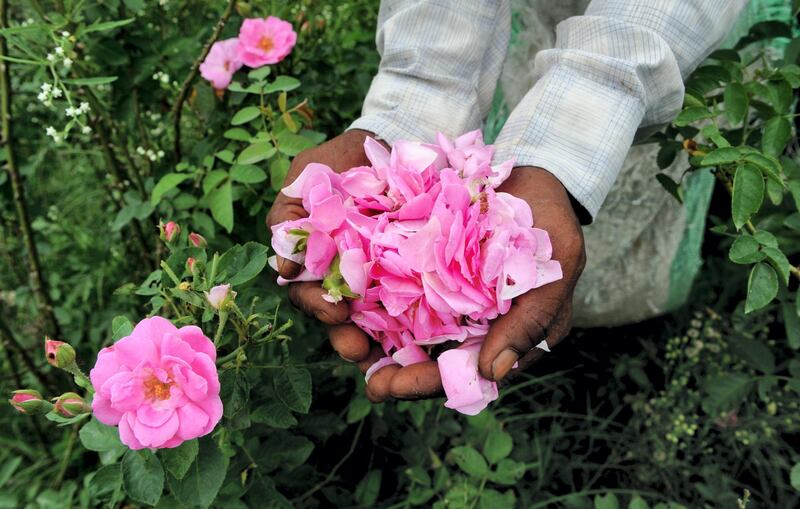“Did you know that the late Nawab, Wajid Ali Shah, was a kathak dancer?” my guide Ajay Jain asks. I am surprised by the revelation. I am aware that the arts and crafts scene had flourished in Lucknow, the capital of India’s Awadh province during the Nawab era, but that the ruler himself danced is something I wasn’t aware of. “Ooh yes he danced, and it is said he sweated a lot, so he would wear the henna attar,” Jain adds.
The mention of attar or ittar (the Arabic word for perfume) caught my attention. The earliest record of perfume-making in India can be found in the Brihat Samhita, an encyclopaedia authored by the philosopher Varahamihira – a 6th century Indian astronomer, mathematician, and astrologer who lived in Ujjain.
Attars are distillates of flowers, herbs, spices and other natural materials such as baked soil over sandalwood oil or liquid paraffin using hydro distillation techniques that are still in use today in Kannauj in India. Some of the first fans of the oils were the Mughal nobles of India. After the decline of the Mughal dynasty in the 18th century, the Nawabs governed Awadh and became its rulers. Court historian Abu’l-Fazl ibn Mubarak chronicled Mughal emperor Akbar’s regular usage of attar and incense sticks in the Ain-e-Akbari (Constitution of Akbar) – a 16th-century detailed document.
Primarily a botanical extract single note fragrance, attar is also used to make perfumes in the west. A natural scent, it is devoid of alcohol and hence thought to have been approved by the Prophet Mohammed.
“You should visit Kannauj – the Grasse of the East to understand the art of attar making,” Jain suggests. It is a two-hour drive from Lucknow, so I set off the next day making my way to the dusty city with narrow lanes dotted with brick houses and busy markets, once ruled by King Harshavardhana.
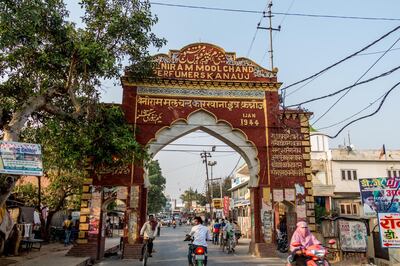
Upon arrival, there’s a huge archway at the entrance of the city that reads: Beniram Moolchand Perfumers Kannauj – since 1944. I dodge the cows idling on the streets and the kids chasing cars. I can’t locate Beniram’s distillation outlet, so instead make my way to Meena Perfumery to talk to Rajat Mehrotra, the third-generation owner.
During its prime, the city was home to many perfume distilleries. Today though, most have moved towards the essential oils business or been forced to shut up shop due to the decrease in demand.
The companies which continue to produce attar follow the age-old method of steam-distillation, which is time-consuming and does not make use of machines.
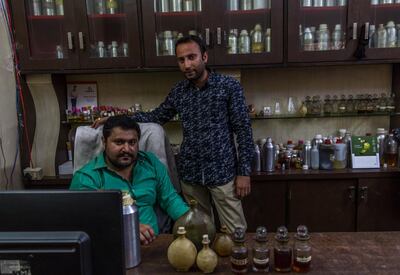
“But why don’t you use machines?” I ask Mehrotra, who owns the distillery with his brother, Amit. “Quality,” he says. The perfumers here are neither chemists nor hold degrees in the craft, but they have the skills that are required to manufacture attar of the best quality.
The natural fragrance is extracted from barks like oud, herbs, spices and flowers like rose, kewda or screw pine, marigold, henna and jasmine. The perfumers of Kannauj even capture the scent of the rain – petrichor – from the soil. The base required to extract the perfume from these ingredients is sandalwood, jojoba or vetiver. “Sandalwood oil is very expensive and costs 100,000 Indian rupees (Dh4,947) per kilogram. Also, the government doesn’t permit cutting of sandalwood trees. So, we mostly use jojoba as the base for attar,” Mehrotra explains. The attars are made as per the client’s demand. “A kilo of Rooh Gulab attar extracted from rose with sandalwood oil as a base costs about 1,200,000 rupees,” Mehrotra added.
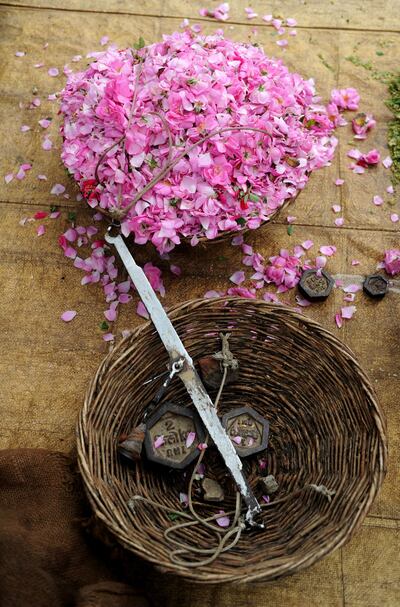
While the cost speaks for the quality and purity of the scent, it also means long hours are spent making it. A rustic and time-honoured set-up continues to function in the distilleries, churning aromas taking one on an olfactory ride. Mehrotra took me to one such functioning plant. Men were seen squatting on a platform beside huge copper vessels called deg with capacity for hundreds of kilos. The pot is heated from below by burning cow dung or acacia wood. It is connected to a long-necked receiver or the bhapka filled with the base (sandalwood/jojoba/vetiver) through a bamboo pipe called chonga.
The bhapka sits in a water tank so that it is cooled. The flowers required for making the perfume are plucked in the early hours of the day and tipped into the deg with water. Heating the vessel releases oil from the flowers, which get condensed as it flows through the pipe to the bhapka. The heating of the deg needs to be well-monitored and controlled by the perfumer.
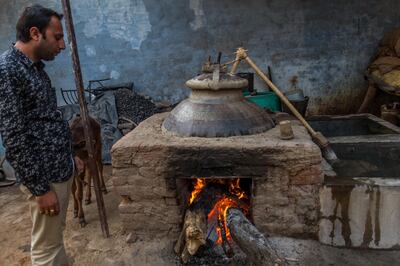
The men sense the heat with their experienced hands and have an ear for the bubbling water. If the pot overheats, the perfume could turn smoky. These skills are passed on from one generation to another – father to son. After the bhapka fills up, it sinks, which is a sign that it needs to be changed – approximately after every three hours. The first batch is called agadi, followed by pichadi and finally the thigadi. These are left to cool overnight and then emptied into the deg with a fresh lot of flowers to be further distilled the next morning. This process continues for 10 to 15 days depending on the concentration of attar desired.
Not every fragrance is favourable for all wearers. There are different variations for men and women, and certain scents are worn depending on the season. There are woody, spicy, musky and floral varieties to choose from. Vetiver extracts are recommended for summer, with the warmer scents like musk for winter. The product isn’t worn on the clothes but directly like a second skin. A drop is enough to fill your senses and your surroundings with a lingering fragrance of the botanical extracts. Just a dab in the pulse points – wrist, behind your ears and the bottom of your neck. It shouldn’t be rubbed vigorously. Dark concentrated attars can stain so shouldn’t be applied to clothes.
The attars of Kannauj have received India’s geographical indication tag for their exclusivity. The attars aren’t limited to the consumer as a perfume, but also go into the making of scented tobaccos and mouth fresheners in India. Rose and kewda attar are used to flavour a wide range of Indian sweets.
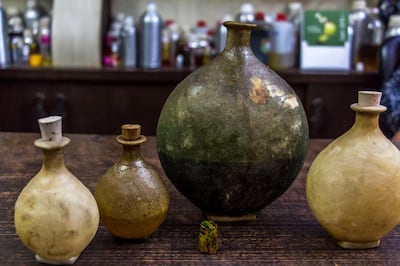
I walked back to Mehrotra’s office. He sat beside cupboards stacked with bottles of all shapes and sizes. He opened a kuppi, a large leather bottle used to store attar. A whiff of the Rooh Gulab was enough to be seduced in a bubble of fragrance that transported me to the redolence of a garden of roses. It was poetry that I carried back home in a vial which broke the lull of my thoughts for many months.
_______________
Read more:
[ My Kind of Place: Lucknow, India ]
[ Travelling Life: William Dalrymple ]
_______________
